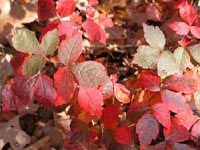Resource Library
Plant of the Week: Sumac, Fragrant
The University of Arkansas System Division of Agriculture does not promote, support or recommend plants featured in "Plant of the Week." Please consult your local Extension office for plants suitable for your region.
Plant of the Week
Fragrant Sumac
Latin: Rhus aromatica

Tucked away in the most obscure part of my yard grows a shrub that is, in its season, as beautiful as any plant in my garden. As a native, it has found its niche under the largest post oak in a site that’s so dry during mid-summer that even the tough perennial weeds fail. Yet every fall the fragrant sumac (Rhus aromatica) glows a lavish orange-red that looks like the glowing embers of a dying bonfire.
Fragrant sumac grows 2-4 feet tall and spreads to 8-feet wide by means of sprawling branches that root when they come in contact with the soil. While most sumacs spread readily by underground rhizomes, the fragrant sumac grows from a fairly compact crown and does its spreading by sending its sprawling limbs in all directions.
But don’t get the impression that this diminutive shrub is invasive. In reality, it spreads quite slowly.
Over its native range, which is essentially east of a line from Minnesota to Louisiana, the plant displays considerable variability. In some regions it grows more as a globe-shaped shrub, while in most places it’s know as a low sprawler. In Arkansas, I’ve mostly seen it on hot, dry exposed slopes peeking out from under the canopy of an overhanging tree.
The tripartite leaves of fragrant sumac are coarsely toothed and glossy green in the summer with the individual leaflets reaching 2 inches in length. To those amongst us that fit the
general description of "knowing just enough to be dangerous," the trifoliate leaves of fragrant sumac could be mistaken for poison ivy. But of course poison ivy is a vine and has larger leaves. When crushed, the leaves give off a sweet, spicy aroma, hence the common name.
The flowers of fragrant sumac appear in early spring, usually just after forsythia has finished blooming. The tiny yellow blooms are borne in panicles and look like 1-inch-long pipe cleaners on the ends of branches. There will often be three or four of these panicles protruding from the tip of a branch, giving the cluster of panicles kind of a bird’s foot appearance.
To my eye, the flowers are what I describe as "more interesting than beautiful." The plants are somewhat undecided about their sexuality, producing both male and female flowers on the same shrub, or sometimes being either male plants or female plants. On the female plants, pea-sized hairy, reddish-maroon berries form small clusters.
Only one selection of this native shrub seems to be common in the nursery trade. ‘Gro-Low’ is a selection made by an Illinois nurseryman that grows 2-feet tall and spreads to 8-feet wide. While fairly popular in the upper Midwest, it’s less common in the South.
A colleague, Dr. Jon Lindstrom, says that any gardener tempted to plant a forsythia should instead plant a fragrant sumac. In addition to the beautiful yellow flowers in spring, you get spectacular fall color. All of this is on a shrub that you don’t have to spend the next 20 years pruning severely every year because it grows so fast.
Fragrant sumac makes an excellent groundcover choice for exposed cuts and unirrigated sites where a tough plant is needed. It will grow in sun or shade. If the planting becomes overgrown, the gentle touch of a brush-hog in early spring just before new growth starts will keep plant height in the desired range.
By: Gerald Klingaman, retired
Extension Horticulturist - Ornamentals
Extension News - October 8, 1999
The University of Arkansas System Division of Agriculture does not maintain lists of retail outlets where these plants can be purchased. Please check your local nursery or other retail outlets to ask about the availability of these plants for your growing area.